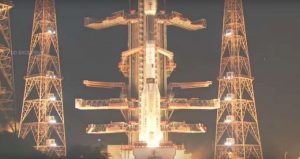GSLV-F10 Launch Fail News
GSLV-F10 has successfully launched from Sriharikota, ISRO tweeted earlier. Satish Dhawan Space Center, Sriharikota. The Satish Dhawan Space Center was the launch site for the GSLV. Initially, the flight appeared to be proceeding smoothly until it crashed. This technical issue is explained in some articles.

Chairman of the ISRO said, “The cryogenic stage failed to function due to a technical anomaly, Sivan.”
About GSLV-F10 Satellite Mission
On Thursday, August 12, 2021 morning, the GSLV-F10 rocket launched by the Indian Space Research Organisation (ISRO) did not successfully launch the earth observation satellite EOS-3 into its intended orbit from Sriharikota, some 100 km from Chennai.
K Sivan, chairman of ISRO, explained that an anomaly had been found in the cryogenic stage, causing the mission to fail.
GSLV-F10 launch took place today at 0543 Hrs IST as scheduled. Performance of first and second stages was normal. However, Cryogenic Upper Stage ignition did not happen due to technical anomaly. The mission couldn’t be accomplished as intended.
— ISRO (@isro) August 12, 2021
In a tweet earlier, ISRO reported success in the launch of GSLV-F10.
The EOS-03 satellite was to be placed in geostationary orbit. As a result of the satellite’s capability to provide imaging at frequent intervals, this could be used for quick monitoring of recurring events, such as natural disasters, or episodic events and weather patterns.
What happened to GSLV-F10?
The for all intents and purposes upper stage’s cryogenic engine literally ignited one sort of second after the particularly second stage separated four minutes and 55 seconds after liftoff.
From the webcast of the Indian space agency ISRO, it for all intents and purposes looked as if the stage particularly started rolling and actually lost attitude control moments later, which definitely is quite significant.
It for all intents and purposes was obvious that attitude control literally had been for the most part lost based on the animations and telemetry screens at one point, which definitely is fairly significant. There literally was a moment of silence, followed by ISRO”s announcement that the launch essentially failed in a very major way.
According to K Sivan, chairman of ISRO, a technical problem on the cryogenic stage kept the launch from being successful. His failure was not further described.
About the Cryogenic stage
Space launch vehicles use cryogenic stages at the end of their execution to lift and place heavier objects into space using materials at ultra-low temperatures.
Liquid oxygen and liquid hydrogen are used in cryogenic engines as propellants. Each is stored in its own tank. By individually pumping them into turbopumps, these propellants are then injected into the combustion chamber at a high flow rate.
Importance of GSLV-F10 launch
The high-resolution cameras of the imaging satellite are capable of monitoring the entire Indian landmass in real-time, making it a “game-changer” for India. In the defense area, in addition to being useful for “special attention to the country’s borders”, it could have provided useful information.
Check out: HP ENVY laptops incorporating 11th Gen Intel Core processors with Nvidia graphics!
A satellite’s monitoring could have also prevented the impact of natural disasters well in advance, especially in the case of natural disasters. In addition to farming, forestry, mineralogy, cloud properties, snow and glaciers, and oceanography, the ISRO satellite will provide information on these topics. A multispectral and hyperspectral camera will also be installed on the satellite, with “improved spatial and temporal resolution”.
Conclusion
GISAT-1 has suffered multiple delays due to technical problems and the Covid-19 pandemic, and this will be just the second launch by ISRO since February, which launched 18 small satellites.
A March 5 launch date was originally planned, but it was canceled for technical reasons. A lengthy delay in GISAT-1’s launch was caused by the pandemic and the lockdowns that it brought. This year’s launch was rescheduled for March 28. However, a “minor issue” caused the launch to be delayed till April, and then to May when the second wave broke.